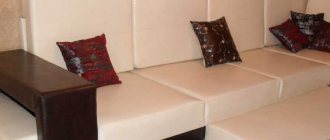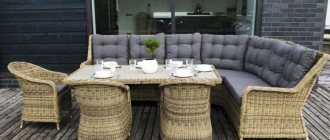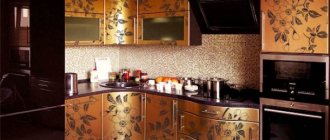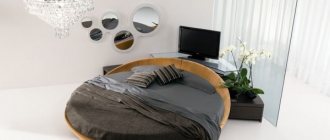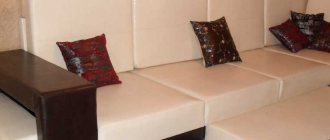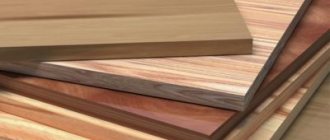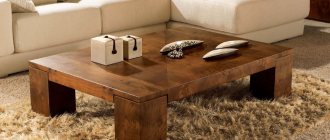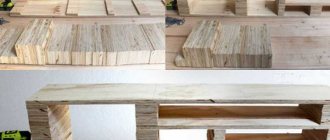10997
Many parents always have difficulties when arranging a children's room. Especially often they cannot choose the right furniture; it is important that it is of high quality and comfortable. The main thing is that furniture elements must correspond to the tastes of children and please them. Of course, furniture stores have a lot of furniture for children, but often parents want to create for their child not just a nursery, but his own corner. Therefore, you can try to make these products. This process is quite labor-intensive, but do-it-yourself children's furniture will be of much higher quality and better than that offered by many manufacturers.
Requirements for children's furniture
Now, in the age of extensive production and active business development, more and more companies are appearing that manufacture and sell furniture. Unfortunately, products do not always meet all quality standards, because in most cases the manufacturer tries to save money by using cheaper materials, and consumers themselves are not averse to spending less money. But savings are not always justified - for example, it is not worth saving on the furnishings of a children’s room, because low-quality furniture can not only be dangerous from a physical point of view (sharp corners and fragility of structures), it can cause significant harm to the child’s health and from the point of view of environmental safety.
Durable and beautiful wooden furniture
Attention! Low-quality furniture made from cheap materials can become a source of formaldehyde, a dangerous carcinogen.
That is why the choice of interior items for a children's room should be treated with special attention and special care. The most stringent requirements are imposed on furniture for children After all, the child’s body is the most vulnerable and must be protected in every possible way from any negative impact.
Children's furniture
Table. Basic requirements for children's furniture.
| Requirement | Explanation |
Materials | For children's furniture, it is recommended to use the most natural and safe materials possible. It is best if it is pure solid wood. All paint and varnish coatings must not be toxic and must not release components hazardous to health into the air. Nails should not be used to connect individual furniture elements - only screws and self-tapping screws are allowed. |
Safety | This is perhaps the most important requirement for children's furniture. Any piece of furniture should not have sharp corners or small elements that are easy to tear off. Handles and other fittings must be safe. If necessary, the edges of the furniture should be covered with a protective edge, which can soften the blow if something happens. It is also worth paying attention to environmental safety - here it is important to choose the right material option used for making furniture. |
Ergonomics and simplicity of design | Furniture for a child should be durable and as simple as possible. It is better to take the option that does not have a large number of parts, but at the same time is characterized by increased strength. It is also important to evaluate the service life of furniture - children grow quickly, and it is better to take some pieces of furniture for growth, and not end-to-end. But this does not apply to desks - here, on the contrary, it is important to choose an option that will not spoil the child’s posture, if we are talking about a schoolchild. |
Design | The ideal option is not to pursue pretentiousness and carved decorative elements, but to opt for a simple but bright design. It is better to pay attention to the color scheme of the furniture than to the decorative decorations on it - this is more important for children. You can decorate furniture with stickers or drawings. It is important to understand that it should appeal primarily to children, not parents. But here it should be remembered that some colors affect the activity of children, and it is also recommended to take this into account when decorating a children's room. |
Functionality | Children's furniture should be not so much beautiful as functional. It is better to focus on those options that have some additional storage space, and some of the elements may be used for other purposes. This will avoid overloading the room with too much furniture. For example, you can store toys under the bed in special drawers. |
Children's bunk bed
Prices for children's bunk beds
Children's bunk bed
Unfortunately, it is rarely possible to find furniture in stores that fully meets all requirements, as well as at a reasonable price. Sometimes it’s easier to do it yourself if you have at least modest skills required for such work. But such furniture will fully meet all the necessary requirements, and will also ideally suit the child’s room in size and design. And most importantly, you can make interior items from materials that meet all your wishes and, first of all, the level of environmental friendliness and safety.
The most necessary furniture for a child
The best workshops on making children's furniture
At home, you can make different designs that will be appropriate in your child’s room. The most common models are not at all difficult to implement. There are a lot of examples in open sources on how to make children's furniture with your own hands.
Frameless pouf
The simplest furniture models that you can make with your own hands are frameless poufs. To make it you will need fabric, thread, a sewing machine and filler. The cover can be made of dense material, for example, raincoat fabric. Foam balls are used as filler.
Sequencing:
- The cover is cut out in the desired shape: round, elongated, square.
- The edges are neatly stitched.
- The side that is sewn last is filled with filler.
To prevent the air from stagnating inside, it is recommended to leave small holes in the case for ventilation. However, you need to make sure that they are of a size through which the contents of the pouf will not spill out. Do-it-yourself frameless furniture will become softer if you additionally sew a cape onto it.
Filler selection
Cutting out the parts for the case
Stitching parts
Filling the bag
The chair is ready
Simple bed
The bed can also be made at home from old furniture. You will need fastenings: corners and screws, as well as non-toxic glue and varnish that covers the product. Tools needed: screwdriver, screwdriver, wood saw, sandpaper.
Making the bed:
- A drawing is created with the required dimensions.
- The bed parts are cut out from it.
- All elements are processed with sandpaper and varnished.
- The parts are connected using corners and self-tapping screws.
- A mattress is placed on the bottom.
The legs of the bed are made of bars, and the bottom is made of slats that allow air to circulate. The backs are cut out in the form of rectangles, as well as the bottom, which should be sized according to the height of the child.
Create a drawing
Cutting out the parts
Grinding
Painting
Assembly
Installation and decoration
Plywood playhouse
Such a “home” will be interesting for any child to play with. For a children's house, it is necessary to determine the height of the floors: the dolls with which the baby plays must fit into it at full height. For the work you will need the following materials and tools: plywood, drill, jigsaw, nails, hammer, wood glue, paint or varnish, paint brushes, pencil, ruler.
Sequencing:
- According to the drawing, parts are cut out of plywood using a jigsaw.
- The edges of the sheets are sanded.
- You can make window openings in the blanks for the “walls”.
- After this, the parts are assembled using glue and secured with nails.
You can install LED light bulbs in the house, and also make furniture for dolls with your own hands.
Drawing selection
Cutting and marking parts
Sanding elements
Painting
Assembly and decoration
Modular sofa made of cardboard
Despite the fact that cardboard is a paper material, furniture made from it is quite durable and functional. The sofa can be made from large boxes, for example, from household appliances. For work you need: PVA glue, furniture stapler, stationery knife, ruler, upholstery fabric, foam rubber.
Step-by-step tips on how to make furniture for dolls with your own hands
Stages of work:
- A square-shaped sample is drawn on a piece of Whatman paper. It must match the child's height.
- A backrest, also equal in height, is attached to it - a vertical rectangle.
- Using this template, about fifty identical blanks are cut out of cardboard. Strips of the same material are used as gaskets, which are glued together in pairs. The required number of parts is 100 pieces, corresponding in height to the sofa and equal in width to the back, 200 strips - equal to the height of the seat.
- Gaskets are glued to the first blank: long - to the back, short - in the seat area to the middle and to the edge.
- This is how all the prepared elements are glued together. The resulting sofa frame should dry.
- Prepared Whatman paper and foam rubber are glued to the product, after which the workpiece is dried again.
- At the last stage, a pre-sewn cover is put on the sofa and secured with a stapler.
You can prepare several such modules of children’s furniture with your own hands and rearrange them during operation according to the child’s wishes.
Cut and glue cardboard pieces
Stick foam rubber
Pull the covers
Chair made of thick foam rubber
To make a chair with your own hands for a child's room, thick foam rubber is also suitable. Furniture made from this material will be light and comfortable. To make it you will need foam rubber, PVA glue, and a knife.
Sequencing:
- Blanks are cut out in the shape of the letter “L” - you will need 5 of them.
- They stick together.
- The top of the chair is covered with soft fabric.
To prevent the joints from being felt, you can additionally use felt or batting, which are glued to the module.
Cut out parts from foam rubber
Glue elements
Put on the cover
What materials can be used?
If you have decided to make furniture for the nursery yourself, then first of all you need to decide on the type of material that will be used. Basically, all children's furniture is made of wood or its derivatives, but plastic or metal elements can additionally be used, depending on the wishes and capabilities of the master.
Children's wooden bed
Important! It is best to use the material that will meet the maximum requirements in terms of environmental safety.
The material used to create homemade children's furniture must be:
- durable;
- durable;
- reliable;
- environmentally friendly.
Children's plastic furniture
Solid wood
The ideal option for creating children's furniture is pure wood, solid wood. This is the most natural and safest material for health from any point of view. It does not emit any harmful substances, which means you don’t have to worry about it. In addition, the wood is easy to work with, has high strength characteristics and can withstand the load that even very active guys put on it.
Bed made of solid beech
Typically, oak, beech, maple, pine, walnut and a number of other species are used to make wooden furniture. But the most budget-friendly, affordable and simple option is pine boards. Unfortunately, they are not designed for high loads due to their softness, but they will withstand the activity of children's games if you choose the thickness of the array wisely. The most durable types of wood are walnut and oak. Such furniture will be of no use even after many years of intensive use in a large family.
On a note! The natural grain of wood looks quite nice, and sometimes there is no need to decorate such furniture additionally. But it is still worth varnishing the wood to avoid darkening and loss of the external beauty of the material.
Rocking bed
Chipboard and MDF
This is a material quite often used to create homemade furniture, but it is not recommended to place such furniture in a children's room. The fact is that in the production of chipboard, very dangerous chemicals are often used, which can provoke the development of serious diseases or an allergic reaction. These components are especially dangerous for children.
But chipboard is distinguished by its high strength and durability, as well as its low price. Fortunately, there are high-end slabs on sale that are used in Europe for furniture production. They are as safe as possible for people, including children’s health, and they can be used. But this is the most expensive option for chipboard, so sometimes it will be cheaper to buy even solid wood.
Children's furniture made of chipboard
On a note! Chipboard can have different colors of facades, which allows you to choose a fairly bright and beautiful option. But this material is afraid of water - it is much more dangerous for it than for solid wood.
By the way, there is another material that is produced almost in the same way as chipboard - MDF panels. They are also made from sawdust, but no resins containing dangerous formaldehyde are used during production. In terms of other properties, MDF is very similar to chipboard.
Chipboard and MDF
Plywood
This is a good and inexpensive material for creating children's furniture, easy to work with and not as dangerous as chipboard. Making anything from it is easy and simple; you don’t have to spend a lot of effort or purchase expensive equipment. But you should choose those plywood sheets that are of fairly good quality and at least 1.5 cm thick. It is also better to choose an option that has increased resistance to water.
Children's furniture made of plywood
On a note! Some companies that sell plywood offer to cut the sheets immediately upon purchase. In this case, all that remains is to assemble the piece of furniture at home using self-tapping screws and a screwdriver.
Materials
The furniture departments offer a wide range of products for the children's room, made from different materials. Each has its own pros and cons that need to be taken into account when choosing. The main requirements for them are: environmental safety and high quality.
| Material | Description | pros | Minuses |
| Tree | The frame is made from solid wood | Environmental safety, absence of emitted harmful substances. Natural color, pleasant woody smell | Sensitivity to humidity and temperature changes, which leads to swelling or cracking. High price. Soft woods are susceptible to dents and scratches if not handled carefully. |
| MDF | The frame is made of compressed wood boards covered with plastic, veneer or synthetic film | High strength. Environmentally friendly material, as it does not contain carcinogens and synthetic resins. Various designs of furniture products, attractive appearance | The surface may be damaged during play, causing the veneer or film to peel off. High price |
| Chipboard | Furniture is made from particle board, the surface of which is covered with paints, veneer or film | Low cost. After treatment with special compounds, the material acquires fire resistance and durability properties. | Toxic material (except class E1) |
| Plywood | The frame is made of plywood sheets, the surface is laminated or veneered | Furniture made from high-quality plywood is strong and durable. Variety of design solutions. Low cost | Low-quality material contains formaldehyde and synthetic resins, which lead to allergies. Strength characteristics are lower than those of wood and MDF. The surface is highly susceptible to deterioration |
| Plastic | The main types of plastic structures: tables, chairs, chests of drawers, doll furniture | Light weight products, compactness. Interesting design and various colors. Low cost. Easy care | Low-quality plastic is toxic. Quite fragile material |
| Cardboard | To make furniture you need cardboard with a corrugated insert. Suitable for making a children's house with your own hands | Environmentally friendly. Quite durable furniture if properly processed. Light in weight. Does not require large financial investments; Unusual design | Does not tolerate humidity and temperature changes |
| Foam rubber | The main type of products made from it is upholstered furniture | A light weight. Mobility of the structure. Low cost | Poor quality material quickly loses strength characteristics |
Raw materials should not emit harmful substances that can harm children.
Thick burlap or cotton fabric is used as a covering material for furniture. They cover springs and other frame elements, and also sew back covers. Beautiful, practical materials are used for upholstery: jacquard, tapestry, chenille, velor, flock and others. These fabrics are durable and easy to care for, and are not subject to rapid wear.
Features of choosing youth furniture, popular interior styles
You may also need various compositions: varnishes, paints, emulsions that protect the surface from environmental influences. When assembling furniture, the following fasteners are required: screws, nuts, screws, self-tapping screws, eccentric couplers, dowels and corners. Drawings and assembly diagrams are easy to find on thematic resources.
Tree
MDF
Chipboard
Plywood
Plastic
Cardboard
Foam rubber
Velours
Chenille
Tapestry
Jacquard
Flock
What else will you need?
Depending on how and what the children's furniture is made from, other materials may be required. So, it is necessary to use self-tapping screws or self-tapping screws as fasteners, but it is better to avoid nails due to their unreliability.
Universal wood screws with countersunk head
There is furniture that needs to be finished with fabric. In this case, it is important to take not only durable, but also traditionally environmentally friendly materials. Fillers, if any, must also meet all health safety requirements.
If the furniture will be painted or varnished (and objects made of wood or plywood will have to be coated with them in any case), then it is important to look at the composition and purpose of the paints and varnishes. They should not be hazardous to health, should not provoke allergies, etc.
You may also need various types of fittings (corners, closers, handles, etc.) and some decorative elements. The main thing when choosing is to remember that they must be reliable and safe.
When it comes to children's furniture, design is often sacrificed for ergonomics, but even in this case the furniture sometimes turns out to be short-lived.
On a note! The easiest way to decorate children's furniture is with drawings made using a stencil, as well as decorative bright stickers. It’s beautiful and practical, and most importantly – simple.
How to make children's furniture?
Making furniture yourself is both a complex, exciting and interesting process. If you have the necessary equipment and skills, you can make truly unique products that, moreover, fully meet safety requirements and wishes regarding the appearance of the interior item. But it is important to understand that you can make high-quality and beautiful children's furniture only with maximum attention and effort.
Plywood furniture for children
The first step is to decide what appearance this or that piece of furniture will have, what dimensions and parameters, color. After this, you need to decide on the material and calculate how much and what you need to buy. It is also important not to forget about fittings and fastening materials.
Important! Particular attention should be paid to the accuracy of measurements when marking and cutting boards/sheets of material. That is why it is important to draw an accurate diagram of the product with all dimensions.
Types of cribs by size and dimensions
Prices for sheet plywood
Plywood sheets
Making a children's chair
Step 1. This version of the chair is made from plywood, but in a similar way, the exact same chair can be made from solid wood. First of all, on a sheet of plywood you need to draw the outline of the parts of the high chair using a pencil and a ruler. In this model, the legs of the chair on one side will diverge to the sides at an angle of 15 degrees, and the height of the back will be 17 cm. In the upper part, the contour of the legs of the chair will close - thus forming an armrest.
First, the details of the chair are drawn
Step 2. All sharp corners, except the bottom of the legs, must be rounded. To do this, you can use a suitable round object.
All sharp corners must be rounded
Step 3. When the shape of the parts of the chair is depicted on the plywood, you need to take a jigsaw and cut out the elements strictly along the lines.
Structural elements are cut out
Step 4. Based on the received part of the legs and armrest of the chair for one side, you need to make the second part. To do this, you need to put the already cut part of the chair on another sheet of plywood and trace it with a pencil, and then cut out the part.
Plywood is marked using an already cut piece
Step 5. Next, all parts must be thoroughly sanded so that there are no sharp edges or splinters.
Sanding parts
Step 6. You also need to make blanks for the seat, backrest and so-called legs, which will help make the chair stronger and hold its legs together across the board.
Preparations for other elements are made
Step 7. You need to make 4 holes in the back and seat for further screwing of the parts.
Drilling holes
Step 8. Now you can coat the wooden elements of the chair with wood primer, dry the layer and sand the surface of the parts.
Re-sanding of parts
Prices for popular models of eccentric sanders
Random orbital sander
Step 9. Next, you need to cover the wooden elements of the chair with paint, first white and then green. Between applying layers of paint, parts must be subjected to intermediate sanding, but only after the first layer of paint has completely dried.
First, the parts are coated with white paint.
And then green
Step 10. On the legs of the chair you need to mark the places where the legs are attached. The locations where holes for fastening are made are also marked.
The places where the legs are attached are marked
Step 11. Now you need to make holes for screwing in screws or self-tapping screws according to the previously applied markings. Holes for self-tapping screws are also made at the ends of the legs.
Then the holes are drilled
Holes in the ends of the legs
Step 12. Next, you need to assemble the frame of the chair by screwing the legs to the legs and armrests.
Assembling the high chair frame
Build process
Step 13. Now you should coat this frame with varnish or special oil for wood.
Subsequent processing of the structure
Step 14. All that remains is to screw on the seat and backrest. The seat is attached to the corners and screws, and the main thing here is not to make a mistake with the length of the fasteners, so as not to drill through the surfaces.
Screwing the backrest
Prices for cordless drill/driver
Cordless drill/driver
Ready-made children's highchair made of wood
Making a tree table
Step 1. With a little effort and imagination, you can make an original but simple table in the shape of a tree for your child. Its tabletop It will be made, like the chair in the instructions above, from plywood. First of all, you need to draw a blank “crown” tabletop on a sheet of plywood and cut it out with a jigsaw.
Cutting out the “crown” of the tabletop
Finished countertop
Step 2. After this, the edges of the tabletop need to be sanded.
Sanding the edges of the tabletop
Step 3. Next you need to draw two trunk legs on the plywood. They will be the same in size, but in the finished version they will be connected to each other by means of a sawn lock. That is, on one of them the drink will be made from below, and on the other - from above. So you need to mark the middle of each workpiece in height.
Legs painted on plywood
Step 4. Next, you need to use the jigsaw again and cut out the legs, and then sand them with sandpaper.
Legs are cut out
Prices for popular models of jigsaws
Jigsaw
Sanding the cut out legs
Step 5. Then on the countertop you need to mark the locations of future holes for self-tapping screws, and then drill these same holes. They are necessary for attaching the legs to the tabletop.
The locations of future holes are marked
Drilling holes
Step 6. Both parts of the legs need to be connected using a saw lock on the elements, and then in the end upper part, mark and drill holes that coincide with the holes in the tabletop.
Leg connection
Holes are drilled in the legs
Step 7. Now you should first prime and then paint the surfaces of the table parts. It is important to dry each layer before continuing work.
First you need to apply primer
Painting table parts
Step 8. All that remains is to assemble all the elements of the table together, and you can install it in the children's room to the delight of the baby.
Assembled table for children's room
Video - Do-it-yourself bed-house
Video - DIY crib
Video - Making a chair and table
As can be seen from everything written above, making children's furniture with your own hands provides enormous opportunities to bring any child's wishes to life. At the same time, if parents treat the production with full responsibility, it will be possible to realize all the ideas of adults from the point of view of caring for the health of the child. The main thing is to choose the right materials, and also decide what type of future children's furniture should have. And remember that there is nothing more environmentally friendly and better than wood for making interior items in a nursery.
Types of designs
The children's room should be divided into three functional areas: a sleeping area, a play area, a creative area and a learning area. Based on this, different types of furniture are used:
- Soft designs. They are installed for sleeping and relaxing, giving the interior a special coziness. To save space in the room, you can choose sofas with additional accessories: shelves, drawers, cabinets. The functionality of such furniture also lies in the fact that at night it is used as a place to sleep, and during the day - for games or reading.
- Play furniture. Often the space in the room is equipped with such items as a do-it-yourself children's kitchen, a puppet theater, a hair salon with a dressing table and various shelves for combs, a hospital complex with medical supplies. It can also be furniture that imitates cars, trains, carriages. Sports complexes, consisting of horizontal bars, swings, and slides, will develop the physical abilities of children.
- Cabinet furniture. It consists of closed structures: pencil cases, cabinets, wardrobes, beds with drawers for bed linen, chests of drawers, tables (computer or bedside). Such DIY products for a children's room should be functional and spacious.
Ready-made sets, consisting of several items, allow you to decorate the room in the same style
Soft
Gaming
Hull
A child’s room can be equipped with the following do-it-yourself furniture set:
- a bed or sofa for sleeping and relaxing;
- desk, study chair;
- a wardrobe for books, writing instruments and a wardrobe for clothes;
- shelves for various things;
- special furniture for toys, for example, a children's kitchen set is in demand;
- sports corner.
Types of children's furniture sets, reasons for their popularity
Soft ottomans will ideally complement the interior of the room and add coziness. They are safe, and you can easily sew them with your own hands using patterns. Frame products are also easy to manufacture. Wardrobes, beds, bedside tables, shelves - you can do all this yourself.


